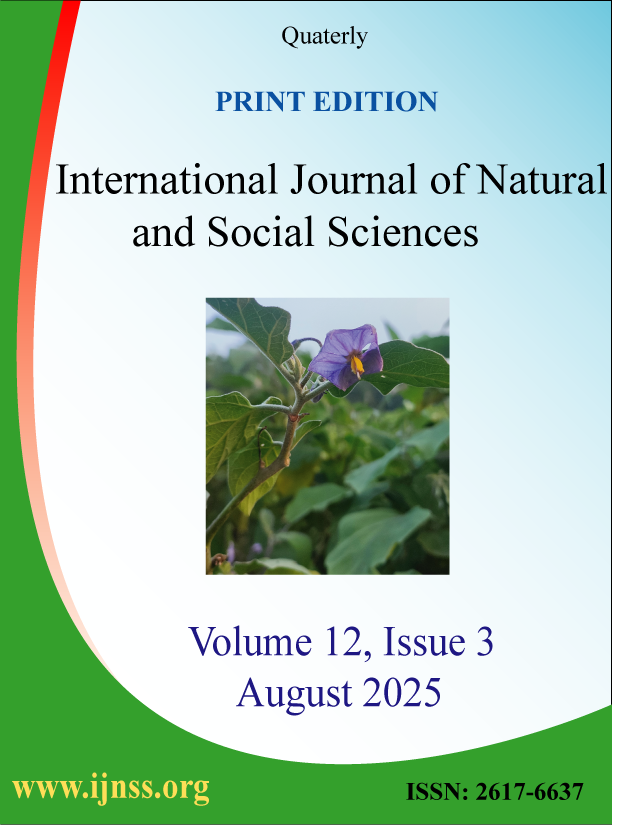Volume 12, Issue 1 (February 2025)
Research, Review and Clinical Articles
Performance and stability of premium quality rice varieties in multi-environment trials using AMMI and GGE biplot during the Boro season in Bangladesh |
|||||
| Authors: Ahmed KK, Hasan MM, Mukul MHR, Shamsunnaher, Zahan A, Morshed MN and Mustakim AAMM; Pages: 01-12 Khandoker Khalid Ahmed1 1Adaptive Research Division (ARD), Bangladesh Rice Research Institute (BRRI), Gazipur-1701, Bangladesh
This study assessed the performance and stability of two advanced rice genotypes, BR9930-2-3-2-2 (V1) and BR9930-2-3-3-1 (V2), compared to three standard varieties- BRRI dhan50 (V3), BRRI dhan63 (V4), and BRRI dhan81 (V5)-across ten agro-ecological zones during the 2021-22 Boro season in Bangladesh. A randomized complete block design (RCBD) was employed with three replications per site to evaluate grain yield, agronomic traits, and genotype-environment interactions (GEI) using AMMI and GGE biplot models. The study revealed significant GEI effects on grain yield, highlighting environmental variability and genotype-specific adaptability. V1 achieved the highest mean yield (6.57 t/ha) with superior performance in several environments, while V2 displayed consistent stability across diverse agro-ecological zones with a mean yield of 6.49 t/ha. The GGE biplot identified V1 as suitable for targeted environments and V2 as the most stable genotype, making it ideal for broader cultivation. These findings underscore the potential of the advanced genotypes for sustainable rice production, particularly in meeting the demand for high-yielding, premium-quality rice in Bangladesh. Further multilocation trials are recommended to validate the stability and adaptability of these genotypes for potential variety release. Keywords: Rice, premium quality, AMMI, GGE biplot, genotype-environment interaction, grain yield, stability.
How to cite this article: Ahmed KK, Hasan MM, Mukul MHR, Shamsunnaher, Zahan A, Morshed MN and Mustakim AAMM (2025). Performance and stability of premium quality rice varieties in multi-environment trials using AMMI and GGE biplot during the Boro season in Bangladesh. International Journal of Natural and Social Sciences, 12(1): 01-12. DOI: 10.5281/zenodo.14728939. |
Performance of organic fertilizer (Plorax Jaibo Sar) on yield and yield attributes of tomato |
|||||
| Authors: Mahaboob MG, Haque ME, Haque MZ, Hossain MS, Mahmud NU and Rahman AKMM; Pages: 13-17 M. Golam Mahaboob1 1Principal Scientific Officer, BARC, Farmgate, Dhaka, 2Scientific Officer, OFRD, BARI, Rangpur, 3Agriculture Expert, CEGIS, 4Agronomist, DCSC, Bangladesh Water Development Board, 5Senior Scientific Officer, RARS, BARI, Jessore, 6Senior Scientific Officer, PRSS, BARI, Gazipur
The experiment was conducted during rabi season 2019-2020 at Agricultural Research Station, On Farm Research Division, Alamnagar, Rangpur to find out the useful effects of organic fertilizer on growth and yield of tomato. The experiment was arranged in a randomized complete block design (RCBD) with five treatments in three (03) compacted replicate blocks. The treatments included T1: 100% Recommended Chemical Fertilizer (RCF), T2: 85% CF + 3 tha-1 organic Fertilizer (OF), T3: 85% CF + 1 tha-1 OF, T4: 70% CF + 3 tha-1 OF and T5: 70% CF + 1 tha-1 OF. The highest yield was observed in T2 (52.22 t ha-1) due to more number of fruit plant-1& weight of fruit plant-1 and the lowest was in T5 (48.81 t ha-1). The highest gross return (BDT. 626640 ha-1) was found in T2 treatment and the lowest gross return (BDT. 585720) was recorded from T5. The highest gross margin (BDT. 358140 ha-1) was obtained from T1. The lowest gross margin (Tk. 310253 ha-1) was obtained from T5. Combinations of organic manure with mineral fertilizer resulted in a higher fruits yield than the sole mineral fertilizers. Based on the results, this study, recommends the use of organic manure with mineral fertilizers for improved tomato fruit yield while maintaining high soil fertility. Hence, the utilization of organic fertilizers, either alone or in conjunction with chemical fertilizer, markedly enhanced the growth and yield of the tested vegetable, offering viable strategies for enhancing the yield potential. Keywords: Organic Fertilizer, Chemical Fertilizer, Tomato Yield, Growth Performance.
How to cite this article: Mahaboob MG, Haque ME, Haque MZ, Hossain MS, Mahmud NU and Rahman AKMM (2025). Performance of organic fertilizer (Plorax Jaibo Sar) on yield and yield attributes of tomato. International Journal of Natural and Social Sciences, 12(1), 13–17. DOI: 10.5281/zenodo.15030451. |
Effect of different weed interference period on growth and yield performance of upland cotton varieties |
|||||
| Authors: Harun-Or-Rashid AKM, Anwar P, Hasan AK, Uddin MR and Amin MR; Pages: 18-31 A. K. M. Harun-Or-Rashid1 1Project Director, Development of Cotton Research and Technology Transfer Project, Cotton Development Board, Tula Bhabon, Krishi Khamar Sarok, Farmgate, Dhaka
This study investigates the impact of weed interference periods on the growth and yield of cotton, emphasizing the critical weed control period (CPWC) for effective management strategies. Conducted over two growing seasons, the experiment utilized three cotton varieties (CB-15, CB-hybrid-1, and Rupali-1) under varying weed interference durations. Treatments included season-long weed-free conditions and periods of weed interference starting at different growth stages. Results indicated that all varieties exhibited the highest seed cotton yield in continuous weed-free conditions, with Rupali-1 achieving optimal yield when maintained weed-free up to 60 days after sowing (DAS). Total dry weed weight increased with prolonged interference, adversely affecting cotton growth and height. Conversely, longer weed-free periods led to significant increases in above-ground biomass and overall plant height. The findings demonstrate that effective weed management, particularly during the early growth stages, is crucial for maximizing cotton yield. The CPWC was identified as essential for optimizing herbicide use and implementing alternative weed management strategies. The study concludes that keeping the cotton field weed-free up to 60 DAS was found necessary to get highest yield which is similar to season long weed-free condition. Removing weeds after 60 DAS brings no advantage in terms of cotton yield. Keywords: Weed interference, Cotton, Varieties, Growth Performance.
How to cite this article: Harun-Or-Rashid AKM, Anwar P, Hasan AK, Uddin MR and Amin MR (2025). Effect of different weed interference period on growth and yield performance of upland cotton varieties. International Journal of Natural and Social Sciences, 12(1), 18–31. DOI: 10.5281/zenodo.15062238. |
Marketing system and consumer attitude towards pangas fish in selected areas of Mymensingh district |
|||||
| Authors: Islam MS; Pages: 32-43 Senior Planning Officer, Bangladesh Rice Research Institute, Gazipur-1701
This study aims to examine the marketing system and consumer attitudes towards pangas fish in selected areas of the Mymensingh district. It is based on primary data collected from three upazilas: Trishal, Muktagacha, and Sadar. A total of 108 samples were randomly selected, including 10 fish farmers, 10 beparis, 10 aratdars, 10 paikers, 20 retailers, and 48 consumers. The study identified four different channels in the current pangas fish marketing system. Consumers generally expressed a positive attitude towards pangas fish. However, a greater quantity of fish needs to be produced to bridge the gap between supply and demand. The study revealed that while many appreciate its affordability, taste, and year-round availability, concerns about farming practices, especially the use of poultry litter, were notably raised. Both producers and traders reported several challenges, including insufficient knowledge and technical support, a lack of quality fingerlings, high prices for various inputs, inadequate transportation and communication facilities, price instability, and a lack of market information. The findings indicate that the marketing of pangas fish is a profitable business. Based on these insights, several recommendations were made to improve the marketing of pangas fish in the country. Keywords: Consumer attitude, Supply-demand gap, Pangas, Production and marketing challenges.
How to cite this article: Islam MS (2025). Marketing system and consumer attitude towards pangas fish in selected areas of Mymensingh district. International Journal of Natural and Social Sciences, 12(1): 32-43. DOI: 10.5281/zenodo.16371986. |
A comprehensive assessment of poultry husbandry practices at DK poultry farm, Chattogram, Bangladesh |
|||||
| Authors: Ghosh M, Sarkar CK, Kundu SR, Lovlu MAH, Sarker S and Imam T; Pages: 44-51 Marina Ghosh1 1Veterinary Surgeon, BRAC, Mymensingh, Bangladesh
This study was carried out at D K Poultry Farm in Chittagong from September 3 to September 17, 2024, aiming to evaluate various management practices for a flock of 4,027 layer hens housed in a three-tier cage system. The research focused on key aspects such as housing conditions, feeding protocols, lighting, production efficiency, and disease management to identify factors influencing productivity and health. The hens’ body weights averaged around 1.89 kg and 1.94 kg at different measurement points within the study period. Mortality rates were exceptionally low, recorded at 0.074% during the 34th week and 0.024% in the 35th week, indicating effective management and health practices. Daily feed intake per bird was approximately 42.65 grams, providing insights into nutritional management. Egg production metrics revealed that peak productivity occurred around the 35th week, with an average of 87.67% egg production per hen per day and reaching a maximum of 87.76%. These results suggest that hens achieve their highest egg-laying capacity near the 35th week of age, highlighting the importance of optimal management practices during this critical period for maximizing productivity. Overall, the study underscores effective farm management strategies to enhance egg production and maintain flock health. Keywords: Performance, Management, Layer, Housing.
How to cite this article: Ghosh M, Sarkar CK, Kundu SR, Lovlu MAH, Sarker S and Imam T (2025). A comprehensive assessment of poultry husbandry practices at DK poultry farm, Chattogram, Bangladesh. International Journal of Natural and Social Sciences, 12(1): 44-51. DOI: 10.5281/zenodo.16911557. |






